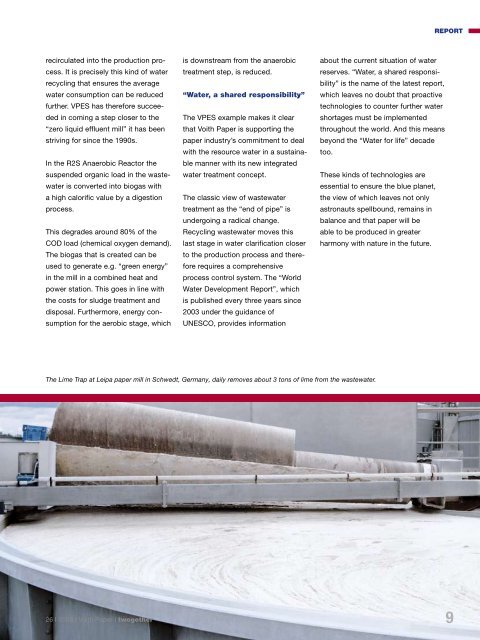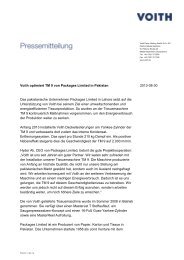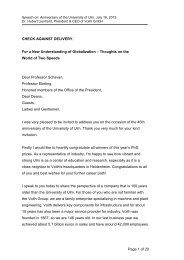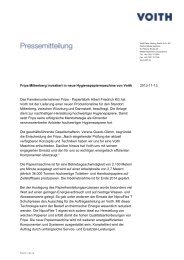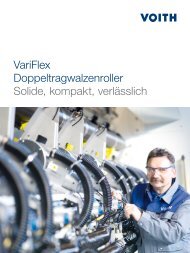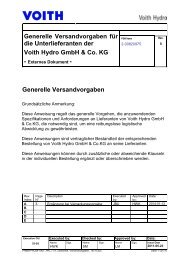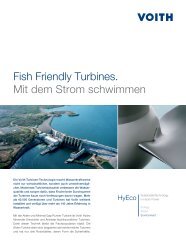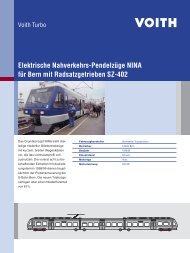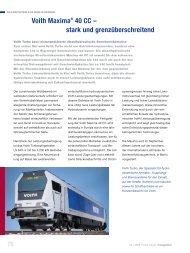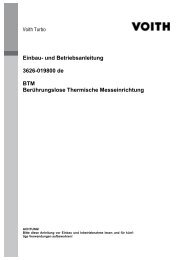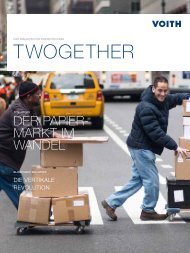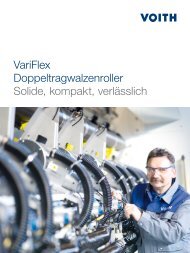2 Water for life requires inventiveness I Daio Paper Mishima ... - Voith
2 Water for life requires inventiveness I Daio Paper Mishima ... - Voith
2 Water for life requires inventiveness I Daio Paper Mishima ... - Voith
You also want an ePaper? Increase the reach of your titles
YUMPU automatically turns print PDFs into web optimized ePapers that Google loves.
ecirculated into the production process.<br />
It is precisely this kind of water<br />
recycling that ensures the average<br />
water consumption can be reduced<br />
further. VPES has there<strong>for</strong>e succeeded<br />
in coming a step closer to the<br />
“zero liquid effluent mill” it has been<br />
striving <strong>for</strong> since the 1990s.<br />
In the R2S Anaerobic Reactor the<br />
suspended organic load in the wastewater<br />
is converted into biogas with<br />
a high calorific value by a digestion<br />
process.<br />
This degrades around 80% of the<br />
COD load (chemical oxygen demand).<br />
The biogas that is created can be<br />
used to generate e.g. “green energy”<br />
in the mill in a combined heat and<br />
power station. This goes in line with<br />
the costs <strong>for</strong> sludge treatment and<br />
disposal. Furthermore, energy consumption<br />
<strong>for</strong> the aerobic stage, which<br />
26 I 2008 I <strong>Voith</strong> <strong>Paper</strong> I twogether<br />
is downstream from the anaerobic<br />
treatment step, is reduced.<br />
“<strong>Water</strong>, a shared responsibility”<br />
The VPES example makes it clear<br />
that <strong>Voith</strong> <strong>Paper</strong> is supporting the<br />
paper industry’s commitment to deal<br />
with the resource water in a sustainable<br />
manner with its new integrated<br />
water treatment concept.<br />
The classic view of wastewater<br />
treatment as the “end of pipe” is<br />
undergoing a radical change.<br />
Recycling wastewater moves this<br />
last stage in water clarification closer<br />
to the production process and there<strong>for</strong>e<br />
<strong>requires</strong> a comprehensive<br />
process control system. The “World<br />
<strong>Water</strong> Development Report”, which<br />
is published every three years since<br />
2003 under the guidance of<br />
UNESCO, provides in<strong>for</strong>mation<br />
about the current situation of water<br />
reserves. “<strong>Water</strong>, a shared responsibility”<br />
is the name of the latest report,<br />
which leaves no doubt that proactive<br />
technologies to counter further water<br />
shortages must be implemented<br />
throughout the world. And this means<br />
beyond the “<strong>Water</strong> <strong>for</strong> <strong>life</strong>” decade<br />
too.<br />
These kinds of technologies are<br />
The Lime Trap at Leipa paper mill in Schwedt, Germany, daily removes about 3 tons of lime from the wastewater.<br />
essential to ensure the blue planet,<br />
the view of which leaves not only<br />
astronauts spellbound, remains in<br />
balance and that paper will be<br />
able to be produced in greater<br />
harmony with nature in the future.<br />
RePoRT<br />
9


